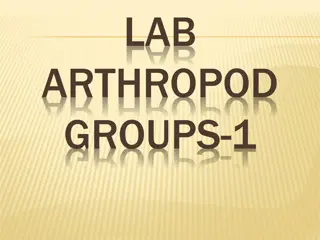Understanding the Structure and Function of Exoskeletons in Animals
An exoskeleton is an external skeleton made of chitin and other substances that supports and protects various animals, such as insects and crustaceans. This rigid or articulated envelope does not grow with the animal, requiring molting to shed the old exoskeleton for a new one. The structure include
0 views • 24 slides
Understanding Exoskeletons: Structure, Function, and Diversity
Exoskeletons are rigid coverings that support and protect the bodies of various animals, serving vital roles in structure, defense, and movement. They vary in composition, such as chitin in arthropods and bone in vertebrates like turtles. This comprehensive overview explores the significance, types,
0 views • 4 slides
Overview of Arthropods: Classification and Characteristics
Arthropods are a diverse group of invertebrates characterized by segmented bodies, appendages, and chitinous exoskeletons. They belong to the Phylum Arthropoda and are classified into four important classes: Myriapoda, Crustacea, Arachnida, and Insecta. This article explores the unique features of e
0 views • 18 slides
Understanding Human-Machine Interaction: A Comprehensive Overview
This comprehensive overview explores the intricacies of human-machine interaction, delving into topics such as output modalities, interacting machines, complex interfaces, real-life applications, examples, neuroplasticity effects, training dynamics, and key concepts in HMI design. Covering a wide ar
0 views • 11 slides
Arthropod Biomimicry: Designing Protective Body Armor for Post-Apocalyptic Survival
In a scenario where groups are preparing for the end of the world, the concept of arthropod biomimicry is employed to design protective body armor for humans inspired by the exoskeletons of arthropods. The armor is required to ensure safety, attractiveness, and mimic other arthropod adaptations apar
0 views • 4 slides




